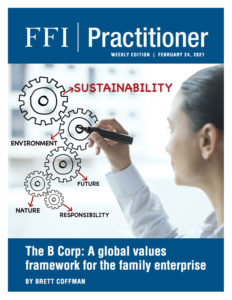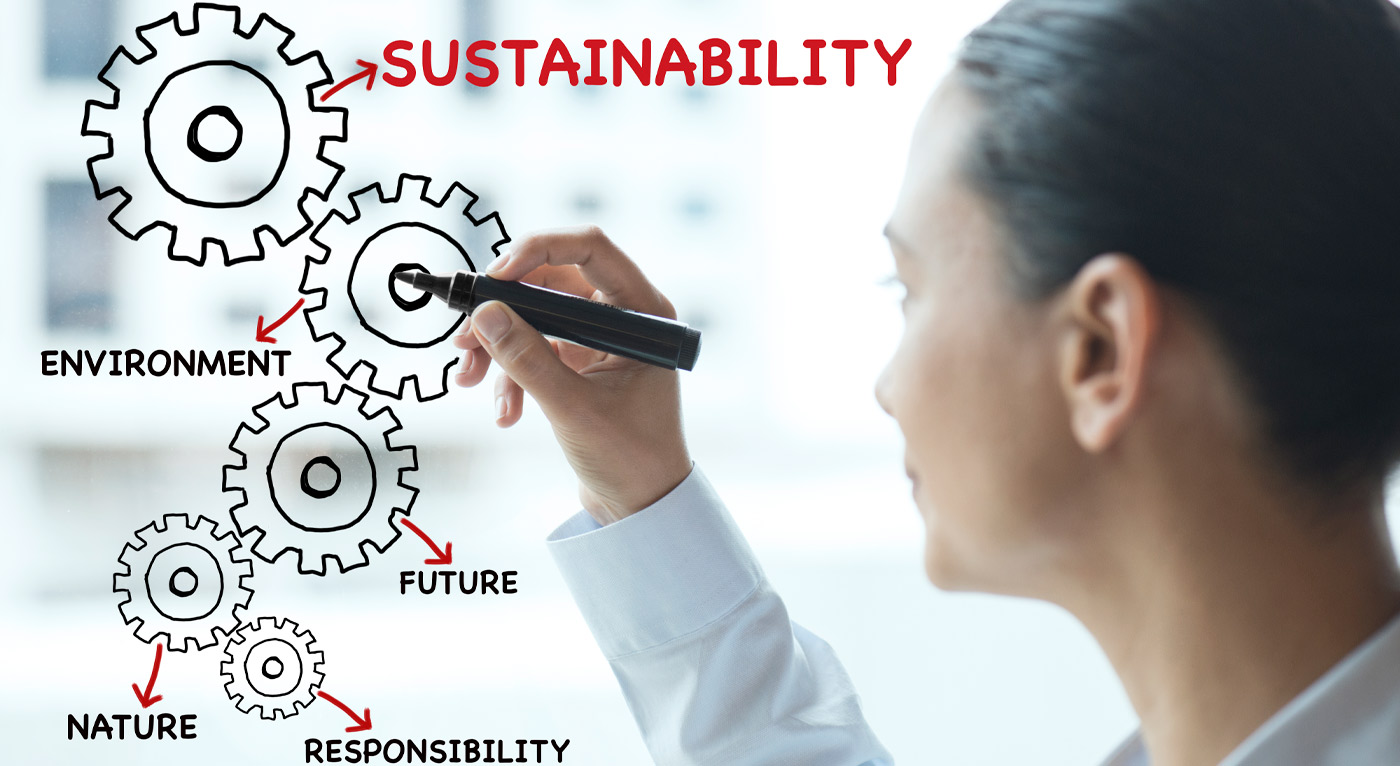
View this edition in our enhanced digital edition format with supporting visual insight and information.
Thanks to Brett Coffman for this week’s edition discussing “B Corps” and how related assessments may provide your family enterprise clients a framework to codify family values around a set of corporate principles that relate to discussions of social responsibility.
Financial performance has long been considered the sole foundation of long-term corporate success. In 1970, economist Milton Friedman provided the basis of shareholder theory by suggesting that “the purpose of a company is to conduct the business in accordance with shareholders’ desires, which generally will be to make as much money as possible, while conforming to the basic rules of the society” (Friedman, 1970). This has created great debate over time, but what cannot be argued is that the worldwide purpose written into underlying corporate structures, and supported by case law in the US, is that corporations are designed to benefit shareholders. This means that no decisions should be made that infringe upon the ability of the shareholder to make profit.
The family business practitioner is well versed in the importance of looking at alternative measures of family success beyond the financial performance of the family enterprise. Analysis of family business models can document and describe how a family will interact as a business-owning family and what values they will seek to perpetuate in order to successfully operate for the long term. However, it continues to be a challenge to develop compelling, transparent, and comprehensive frameworks that can be consistently applied, empower family members, and measure stakeholder progress. B-Corporations (B Corps) can provide family business practitioners with an extensive client framework that widens the business purpose to incorporate all stakeholders through assessment tools and a certification process that incorporates many principles for creating multi-generational enterprises.
Balancing Profit and Purpose
To balance profits and purpose, stakeholder theory provides a guide to governance constituencies, other than solely shareholders, that should be heavily weighted in deriving organizational purpose (Phillips, Freeman, & Wicks, 2003). Other stakeholders can include employees, customers, communities, and suppliers, along with the environment. In addition, other potential success measures include using transparency and legal structures to enhance social, community, and environmental impact, values often identified in family businesses. However, how does a business really measure performance in each of these areas and how can they compare their progress to other businesses?
The B Corp Role
B Corps represent a consistent cross-culture, globally used, governance framework for businesses to meet balanced standards of performance as they scale. The framework evaluates impact and provides valuable feedback in the areas of workers, community, environment, governance, and customers. Businesses who meet rigorous standards in these areas are certified and can advertise being B Corp certified. Consumers who utilize these businesses can be reassured that the social mission has equal importance to product and economic mission. This represents alternative thinking to the shareholder-centered incorporated entity (Kim, Karlesky, Myers, & Schifeling, 2016).
Assessment standards are consistently applied and although self-reported, they are periodically verified by the nonprofit organization, B Lab. B Lab is overseen by The Standards Advisory Council (SAC), which is made up of 20 independent business experts and scholars, who develop and refine the standards by which businesses are assessed. There is a different group within each that assesses developed and developing economies, as businesses in each have differing abilities to benefit all stakeholders.
Assessments are made by industry and size, understanding that some industries by nature create a greater environmental impact than others. As a result, there are 50 versions of the assessment available to family business practitioners based on the business geography, level of economy, business size, and industry. Questions are forward looking, focused on business practices around governance, workers, supply chain, community, charitable giving, customers, and environmental practices. The process is not an evaluation of products or services, but rather of formal policies and procedures with the following goals:
- To reduce inequality
- To lower poverty
- To preserve the environment
- To create stronger communities
- To create high quality jobs
- To create linked prosperity in which all stakeholders connected to the business prosper (Honeyman, & Jana, 2019).
Steps in Becoming a B Corp
The B Impact Assessment Tool and Legal Framework can be accessed through B Lab. There is a free Quick Impact Online Assessment that can be utilized by family business practitioners that takes approximately two or three hours to complete. It is usually completed with the help of the CEO, CFO, COO, or an internal representative. It can then be converted to a more entailed Full Assessment. The following represents the steps in meeting the performance requirements in the certification process (B Lab, Frequently Asked Questions, 2020):
- The business is scored against the B Impact Ratings System developed by the SAC based on global performance standards, and a B Impact Report is generated, based on a scale of 0 to 200. Businesses must score a minimum of 80 to move to the next level and eventually call themselves a Certified B Corporation. The mean score of certificants is 95. Becoming a B Corp does not mean every possible social and environmental improvement must be made without regard to the bottom line, but rather provides a framework to look comprehensively at these issues and advance goals.
- Scores must be made public and public companies must reveal the questions and answers. Companies with over $1 billion in revenue must have results validated by B Lab at their own expense.
- Legal requirements must be met by amending governing documents to provide shareholders the right to hold officers and directors accountable to their social and environmental values, to protect officers and directors from lawsuits over neglecting fiduciary obligations when they considered those values, and to ensure all stakeholders are considered equal. The ownership must agree to the changes, which would then be filed with the Secretary of State or equivalent body outside the US. Within the US, using the Benefit Corporation structure is the only way to meet the legal requirement for B Corp certification in states where Benefit Corporations have been officially recognized.
- To fully adopt the program, the cost is $500-$50,000 USD annually, depending on revenue, which can often be more than offset through B Lab cultivated partnerships (Buerkle, Chang, & Storto, 2018).
- Adoption is made official by signing the Declaration of Interdependence. To make the concepts of B Corps part of the business culture, it is necessary to engage the ongoing team responsible and to create a plan that includes publicizing the accomplishment, focusing on continued improvement, checking in at a platform designed for B Corp certificants called the B Hive, and participating in a B Local group.
- Recertification takes place every two years, with potentially new updated standards. In addition, 10% of members are randomly audited annually.
The first generation of B Corps were certified in 2007, and the number of firms earning certification has grown exponentially ever since. There are now over 3,300 for-profit companies, representing over 150 industries in over 71 countries. It has become an interconnected global community.
Over 50,000 companies have used the assessment, which means that most users do not formally become B Corps but still find value in the framework. This means that the frameworks can be used by a family business that may not choose to certify. While Certified B Corps and Benefit Corporations range from start-ups to publicly traded companies, most of them are privately-owned small and medium enterprises (Buerkle, Chang & Storto, 2018).
Conclusion
Family enterprises know the values they want to perpetuate but may not have a consistent framework to codify those values and ensure that they are built into the culture of their enterprises as they scale. Ongoing assessment work is a journey of continuous improvement and family enterprises would be well served to revisit the paradigm of their corporate values to create interconnectedness among global firms who want to do business, not because the enterprise is in their country or region, but because values and practices align. Nationalistic walls around family enterprises are diminishing because of political and public policy changes, resulting in greater global opportunity and community.
B Corp principles and tools represented through B Lab assessments represent a framework for multigenerational family enterprise stakeholders who seek to codify their family’s most unifying family values around a set of corporate principles, values, and criteria, to ensure a deeply meaningful and ongoing socially responsible family business. Family businesses have the opportunity to contrast their values and work through a similar framework to identify commonalities with other enterprises, be seen as unique, more worthy of partnering with, and creating products and services that are born out of those shared values.
References
B Lab, “Frequently Asked Questions,” https://bimpactassessment.net/how-it-works/frequently-asked-questions/top-10#what-is-considered-a”good”-score (accessed April 10, 2020).
Buerkle, A., Chang, K., & Storto, M. (2018). Just Good Business: An Investor’s Guide to B-Corps. Yale Center for Business and the Environment.
Honeyman, R. & Jana, T. (2019). The B Corp Handbook: How you can use business as a force for good. (2nd Ed.). Berrett-Koehler Publishers, Inc.
Kim, S., Karlesky, M. J., Myers, C. G., & Schifeling, T. (2016). Why companies are becoming B corporations. Harvard Business Review, 17, 1-5.
Friedman, M. (1970). The social responsibility of business is to enhance its profits. New York Times, 32(13), 122–126.
Phillips, R., Freeman, R., & Wicks, A. (2003). What stakeholder theory is not. Business Ethics Quarterly, 13(4), 479-502
Disclaimer: As of the publication date, B Labs and the Standards Advisory Council are the only third-party standards and certification orgs for B corps. This article is general and educational in nature. It is not intended to be, nor should be construed as, legal or tax advice.
About the Contributor

Brett Coffman, FFI Fellow, has over two decades of experience advising business owners. He earned a B.S. in economics from the University of Utah, an MBA from Syracuse University, a certificate in personal financial planning from New York University, an Advanced Certificate in Family Business Advising (ACFBA) from the Family Firm Institute, and is a Cannon Trust School graduate. In addition, he has a Ph.D. in personal financial planning from Kansas State University, with a focus on family business dynamics and succession preparedness. He is an adjunct professor, has been published in the Journal of Financial Planning, is a reviewer for several academic journals, and has been quoted in regional and national media. He can be reached at financialplanner1@hotmail.com.

View this edition in our enhanced digital edition format with supporting visual insight and information.





